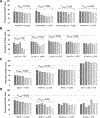Trends in Human Papillomavirus Vaccine Types 16 and 18 in Cervical Precancers, 2008-2014
- PMID: 30792242
- PMCID: PMC6526945
- DOI: 10.1158/1055-9965.EPI-18-0885
Trends in Human Papillomavirus Vaccine Types 16 and 18 in Cervical Precancers, 2008-2014
Abstract
Background: The impact of human papillomavirus (HPV) vaccination has been observed in the United States through declining cervical precancer incidence in young women. To further evaluate vaccine impact, we described trends in HPV vaccine types 16/18 in cervical precancers, 2008-2014.
Methods: We analyzed data from a 5-site, population-based surveillance system. Archived specimens from women age 18-39 years diagnosed with cervical intraepithelial neoplasia grades 2-3 or adenocarcinoma in situ (CIN2+) were tested for 37 HPV types. We described the proportion and estimated number of cases of CIN2+ by HPV-type groups over time. Trends in HPV16/18-positive CIN2+ were examined, overall and by vaccination status, age, histologic grade, and race/ethnicity, using Cochrane-Armitage tests.
Results: In 10,206 cases, the proportion and estimated number of cases of HPV16/18-positive CIN2+ declined from 52.7% (1,235 cases) in 2008 to 44.1% (819 cases) in 2014 (P < 0.001). Declining trends in the proportion of HPV16/18-positive CIN2+ were observed among vaccinated (55.2%-33.3%, P < 0.001) and unvaccinated (51.0%-47.3%, P = 0.03) women; ages 18-20 (48.7%-18.8%, P = 0.02), 21-24 (53.8%-44.0%, P < 0.001), 25-29 (56.9%-42.4%, P < 0.001), and 30-34 (49.8%-45.8%, P = 0.04) years; CIN2 (40.8%-29.9%, P < 0.001) and CIN2/3 (61.8%-46.2%, P < 0.001); non-Hispanic white (59.5%-47.9%, P < 0.001) and non-Hispanic black (40.7%-26.5%, P < 0.001).
Conclusions: From 2008-2014, the proportion of HPV16/18-positive CIN2+ declined, with the greatest declines in vaccinated women; declines in unvaccinated women suggest herd protection.
Impact: The declining proportion of HPV16/18-positive CIN2+ provides additional evidence of vaccine impact in the United States.
©2019 American Association for Cancer Research.
Conflict of interest statement
Disclosure of Potential Conflicts of Interest
L.M. Niccolai is a consultant/advisory board member for Merck. No potential conflicts of interest were disclosed by the other authors.
Figures


Comment in
-
HPV infections most often linked to cervical cancer have declined.Cancer. 2019 Jul 15;125(14):2336-2337. doi: 10.1002/cncr.32349. Cancer. 2019. PMID: 31260094 No abstract available.
Similar articles
-
Cervical adenocarcinoma in situ: Human papillomavirus types and incidence trends in five states, 2008-2015.Int J Cancer. 2020 Feb 1;146(3):810-818. doi: 10.1002/ijc.32340. Epub 2019 May 6. Int J Cancer. 2020. PMID: 30980692 Free PMC article.
-
HPV type-specific trends in cervical precancers in the United States, 2008 to 2016.Int J Cancer. 2023 Jan 15;152(2):137-150. doi: 10.1002/ijc.34231. Epub 2022 Sep 26. Int J Cancer. 2023. PMID: 35904861
-
Reduction in HPV 16/18-associated high grade cervical lesions following HPV vaccine introduction in the United States - 2008-2012.Vaccine. 2015 Mar 24;33(13):1608-13. doi: 10.1016/j.vaccine.2015.01.084. Epub 2015 Feb 11. Vaccine. 2015. PMID: 25681664 Free PMC article.
-
Effects of different-valent vaccines against human papillomavirus (HPV) to prevent persistent HPV16/18 infections and CIN2+ in women: a systematic review and network meta-analysis.Int J Infect Dis. 2025 Feb;151:107363. doi: 10.1016/j.ijid.2024.107363. Epub 2024 Dec 19. Int J Infect Dis. 2025. PMID: 39709117
-
Efficacy and safety of prophylactic HPV vaccines. A Cochrane review of randomized trials.Expert Rev Vaccines. 2018 Dec;17(12):1085-1091. doi: 10.1080/14760584.2018.1548282. Epub 2018 Nov 29. Expert Rev Vaccines. 2018. PMID: 30495978 Review.
Cited by
-
Non-mucosal vaccination strategies to enhance mucosal immunity.Vaccine Insights. 2023 Jul;2(6):229-236. doi: 10.18609/vac.2023.034. Epub 2023 Jul 12. Vaccine Insights. 2023. PMID: 37881504 Free PMC article.
-
Viral Causality of Human Cancer and Potential Roles of Human Endogenous Retroviruses in the Multi-Omics Era: An Evolutionary Epidemiology Review.Front Oncol. 2021 Oct 29;11:687631. doi: 10.3389/fonc.2021.687631. eCollection 2021. Front Oncol. 2021. PMID: 34778024 Free PMC article. Review.
-
Human papillomavirus vaccination coverage among sexually active young adults aged 18 to 26 at a sexually transmitted infections clinic.Int J STD AIDS. 2023 Apr;34(5):315-321. doi: 10.1177/09564624221146605. Epub 2023 Jan 19. Int J STD AIDS. 2023. PMID: 36655673 Free PMC article.
-
Prevalence of human papillomavirus genotypes in high-grade cervical precancer and invasive cervical cancer from cancer registries before and after vaccine introduction in the United States.Cancer. 2021 Oct 1;127(19):3614-3621. doi: 10.1002/cncr.33582. Epub 2021 Jul 21. Cancer. 2021. PMID: 34289090 Free PMC article.
-
Incorporating Stakeholder Feedback in Guidelines Development for the Management of Abnormal Cervical Cancer Screening Tests.J Low Genit Tract Dis. 2020 Apr;24(2):167-177. doi: 10.1097/LGT.0000000000000524. J Low Genit Tract Dis. 2020. PMID: 32243312 Free PMC article.
References
-
- Markowitz LE, Dunne EF, Saraiya M, Chesson HW, Curtis CR, Gee J, et al. Human papillomavirus vaccination: recommendations of the Advisory Committee on Immunization Practices (ACIP). MMWR Recomm Rep 2014;63:1–30. - PubMed

